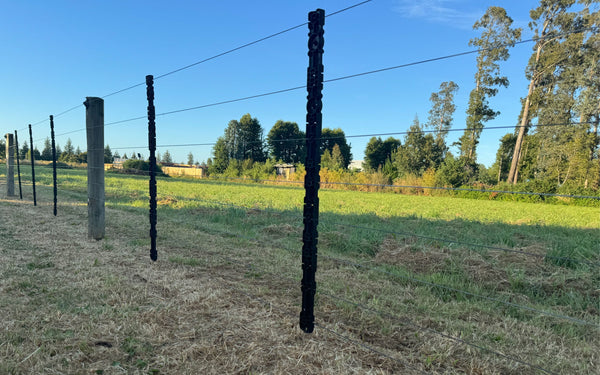How to correctly set up electric fencing
May 16, 2024
Electric fencing is a true, tried, and tested method of containment, but it can cause a headache if not set up correctly from the start.
From outages, to weak currents, to simply what products to use, many questions pop up when it comes to installing electric fencing on your farm or lifestyle block.
The question we at Styx Solutions get asked the most is, “What is the right way to set up electric fencing?”
This article is going to answer that question for you, plus cover a host of other questions we’re always getting asked in our role as fencing specialists.
First things first…
Why use electric fencing?
Electric fencing is a great way to keep animals in or out of a designated area. It uses a harmless electrical shock as a psychological barrier as well as a physical barrier to encourage the animal not to engage with the fence.
Electric fences are useful when used in temporary setups to manage pasture (break feeding) and to set up paddock designs before moving on to more permanent fencing and finalising a fencing layout.
How does an electric fence work?
If an animal touches the wire on an electric fence, an electric circuit is closed. This means the electric current now flows through the animal and the earth back to the unit. The animal consequently receives an unpleasant, though harmless, electric shock and (hopefully!) backs off.
An electric fence system of this kind is used successfully to pen animals in and also to keep other animals out.
An electric fence system consists of:
1. An electric fence unit that generates regular electric pulses
2. One or more wires that transport electricity (these do not necessarily have to form a closed loop)
3. Insulators that isolate the electricity from the earth
4. Permanent or mobile posts that can be used as required
5. The earthing stake connected to the electric fence unit, which should be galvanised and buried as deep as possible into damp soil.



Electric fencing technical terms:
Earth:
The earth is like the foundation for the electric circuit's pathway. To ensure a smooth current flow back to the unit, the earth rod needs to have a solid connection with the soil. Dry earth barely conducts electricity, so when you're placing the earth rod, choose a damp spot or use a longer rod that can reach the deeper, moist layers.
In the world of electric fences, shock voltage is the big spike of power that's generated. It's needed to create a special 'bridge' between the fence wire and the animal's body. A minimum of 2500 V is essential, and for those animals with thicker coats, you'll need at least 5000 V.
Pulse Energy:
Once the shock voltage has created the 'bridge', the current (known as pulse energy) can flow through. The impact of the shock actually depends on the amount of pulse energy, not the voltage itself. The more resilient the animal, the more pulse energy you'll need to keep them secure or give them a fright. The demand for pulse energy also increases with the length of the fence and any external resistive load (e.g. vegetation) that may be present.
Fence Resistance:
To get the best shock and make sure there's minimal energy loss, you'll need a highly conductive fence material. The conductor resistance is a handy way to check the material's quality - the lower the Ohm/meter value, the better the conductor. Ideally, you want materials below 1 Ω/m. While copper wire is great, remember that durability is important too, so materials like stainless steel are worth considering.
What fencing distance figures should you work with?
The distance estimates are often based on perfect scenarios, including top-notch wire conductivity, connections, insulation, and ground conditions.
However, these elements can change due to weather fluctuations, wear and tear on all elements used in the fence construction, and vegetation.
To ensure your fence is always effective, it's crucial to maintain a minimum protective voltage of 2,500 (or 5,000 volts for more resilient animals and drier soils) at every fence point, despite the varying conditions.
How powerful does an electric fence need to be?
An electric fence's power is a crucial factor in making sure it does its job effectively.
When determining the ideal power level, consider the type and size of the animals you're fencing in.
For most animals, a power level of around 2,500 volts is enough to deter them. However, for more robust or larger animals and in dry soil conditions, a higher power level of around 5,000 volts is recommended to ensure their safety and containment.
How do I choose the right electric fence unit?
230 V Power Energizers — your go-to when a mains socket is available
These units offer continuous protection and come in various power classes to meet your specific needs (from 0.5 Joule up to 14.5 Joule output). The higher power being ideal for long fences, fences with vegetation cover, or for containing bigger, more robust animals. Higher energy levels effectively manage containment without harming the animals, and all units meet safety standards. For mobile use, such as in changing pastures or break/strip grazing or where 230 V is not available, consider battery-powered units. Note: for denser vegetation, basic 9 Volt solar units won’t suffice — you’ll need a 12 Volt unit.
12 V Battery Units — strong and reliable for challenging fences
Perfect for tough scenarios where no 230 V connection is available, these 12 V battery units match the power of mains devices and are ideal for thicker vegetation and larger, more challenging animals. They use rechargeable 12 V wet batteries, needing recharges roughly every 2-4 weeks, depending on usage. Adding a solar module can keep the battery topped up by converting solar energy into electrical power.
12/230 V DUO Units — outstanding flexibility with potent output
These units blend the continuous protection of 230 V units with the mobility of 12 V units, making them incredibly versatile. They come equipped with both a 12 V cable for battery use and a 230 V adapter.
9 V Dry Battery Units — great for smaller, simpler setups
These units are best for shorter fence lines without vegetation. They’re lighter and more portable than 12 V units. The 9 V battery runs for a few months and can even cover an entire pasture season depending on the operating time, battery type and size (expressed in Ah – the more Ah (ampere hours), the longer it runs for). While a 9 V battery can last a fencing season depending on usage, once depleted, it cannot be recharged. Although less powerful than 12 V units, high-impact 9 V models can still deliver up to 0.55 joules.
iBZzCompact Solar Units
Choose classic range compact solar units from JVA for smaller fences free of vegetation, or choose from the AKO SunPOWER range for more powerful, mobile options. These units come with crystalline solar modules that can energise lengthy fences for extended periods, even with a week without direct sunlight. Sufficient voltage is supplied everywhere along the fence, without the requirement for a socket anywhere nearby! The integrated 12-volt AGM battery is continuously charged via the built-in solar module and can be recharged with a 230-volt mains adapter when necessary.



Expert tip:
The longer the fence, the more robust the animal, or the thicker the vegetation, the more discharge energy in joules is required. If a socket is available, you should always use a 230-Volt device for the best protection!
Which electric fence wire is the best?
The thicker the wire the less resistance. For permanent fencing using either a top hot wire or multiple wires (with or without battens/ droppers) then high tensile 2.50mm galvanised wire will do.
For semi-permanent fencing or when designing equine fencing, the use of Polywire, Polyrope (Braids), Polytape or coated Equine wire (Topline Horse wire) is acceptable, depending on the resistance per meter of the wire. Resistance is measured in Ohms/meter or kilometer and the lower the resistance the better, as this will improve conductivity over a long distance.
Polytape or wire with smaller diameter stainless steel wires will have an increased resistance compared to tapes or poly wire that use a combination of larger stainless wires and tinned copper wires. Stainless wires help to increase the tensile strength, or breaking load of the tape.
It is important to note that not all Polytape and wires are created equally, and often the cheaper the product the less tensile strength and higher resistance it will have, often coupled with poor UV performance.



